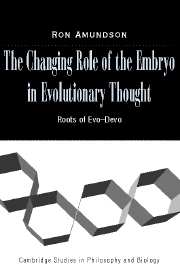Book contents
- Frontmatter
- Contents
- Acknowledgments
- 1 Introduction
- PART I DARWIN'S CENTURY: BEYOND THE ESSENTIALISM STORY
- 2 Systematics and the Birth of the Natural System
- 3 The Origins of Morphology, the Science of Form
- 4 Owen and Darwin, The Archetype and the Ancestor
- 5 Evolutionary Morphology: The First Generation of Evolutionists
- 6 Interlude
- PART II NEO-DARWIN'S CENTURY: EXPLAINING THE ABSENCE AND THE REAPPEARANCE OF DEVELOPMENT IN EVOLUTIONARY THOUGHT
- References
- Index
2 - Systematics and the Birth of the Natural System
Published online by Cambridge University Press: 05 June 2012
- Frontmatter
- Contents
- Acknowledgments
- 1 Introduction
- PART I DARWIN'S CENTURY: BEYOND THE ESSENTIALISM STORY
- 2 Systematics and the Birth of the Natural System
- 3 The Origins of Morphology, the Science of Form
- 4 Owen and Darwin, The Archetype and the Ancestor
- 5 Evolutionary Morphology: The First Generation of Evolutionists
- 6 Interlude
- PART II NEO-DARWIN'S CENTURY: EXPLAINING THE ABSENCE AND THE REAPPEARANCE OF DEVELOPMENT IN EVOLUTIONARY THOUGHT
- References
- Index
Summary
INTRODUCTION
This chapter sketches the development of the practice of systematics and taxonomy from the time of Linnaeus through the time of Darwin. The central topic is the origin and growth of the Natural System. Development of the concept of the Natural System during that period was crucial to Darwin's enterprise. My narrative differs from many others in the ways I see the Natural System to have changed. Traditional reports of pre-Darwinian systematics claim that belief in the fixity of species is ancient. It is said to be founded on the ancient Greek metaphysical principles of essentialism, typology, or both. These principles asserted that natural kinds (including species, higher taxa, chemical elements, and even geometric shapes) were characterized by essences that were distinct and unbridgeable. Biological species had fixed, defining characters in the same sense that geometric figures did. Just as triangles must have three sides, species members must have the characters essential to their species. Just as squares and triangles are separated by an unbridgeable gap reflected in their essential characters, so are species. Darwin's achievement was to overthrow the essentialism–typology doctrine that had governed earlier taxonomic practice, to recognize the variability within species and the continuity between them. This allowed evolutionary transitions to occur. This attribution of species fixism to ancient Greek metaphysics will be termed the Essentialism Story. The Essentialism Story is not just a report of a historical belief but also an explanation of another belief.
- Type
- Chapter
- Information
- The Changing Role of the Embryo in Evolutionary ThoughtRoots of Evo-Devo, pp. 31 - 52Publisher: Cambridge University PressPrint publication year: 2005



